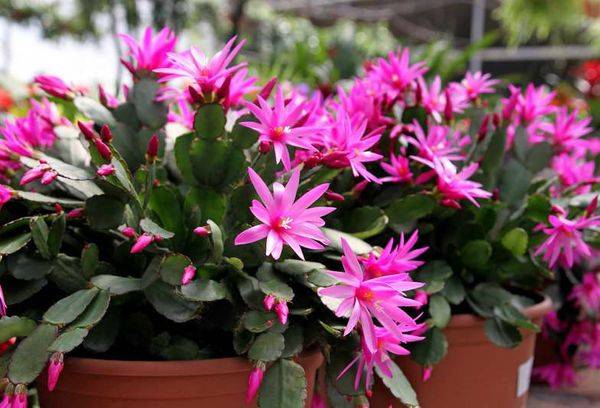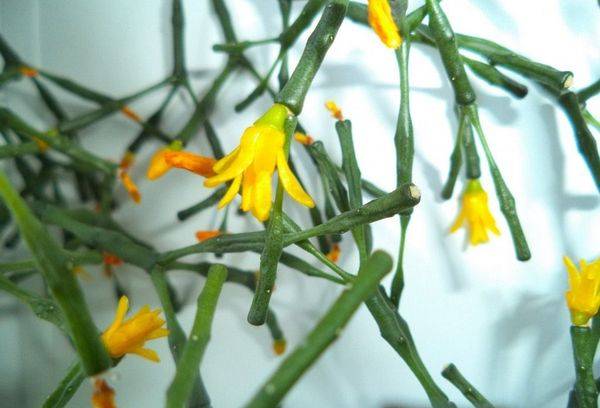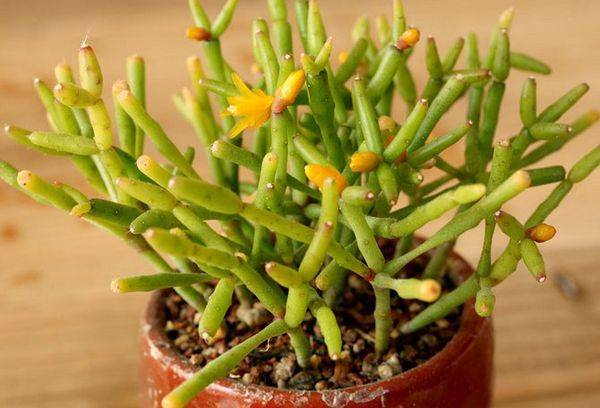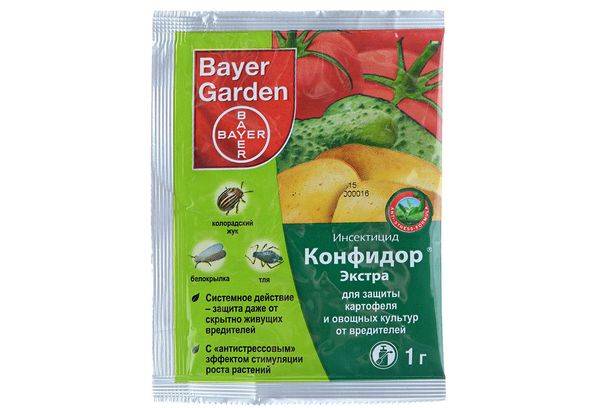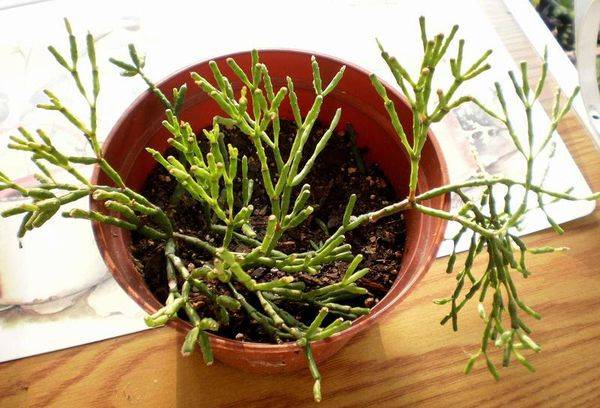What should be the care of the hatiora at home
Content:
A plant that cannot be confused with any other, thanks to its bizarre appearance - a hator. Home care for her is absolutely not complicated, while the plant blooms profusely in the winter months.
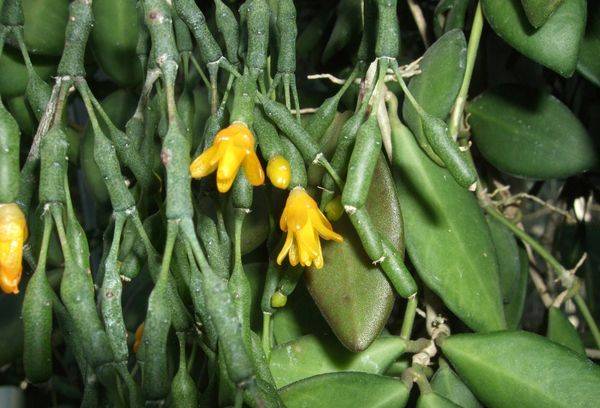
Hatiora Grazer
Description
Hatiora, or, as it is sometimes called by the people, the dancing skeleton belongs to the cactus family and, accordingly, is a succulent. The plant has unusual segmented stems, growing in all directions, for which it received a humorous nickname. Under natural conditions, it can reach two meters in height. For the first time, the hator was seen in the tropical climate of Brazil and is therefore considered exotic.
Common habitats are crevices of rocks, trees. Hatoria shoots stretch vertically upwards, but over time wilted. At three to four years of age, the plant becomes very similar to a small tree, as the trunk gradually becomes stiff.
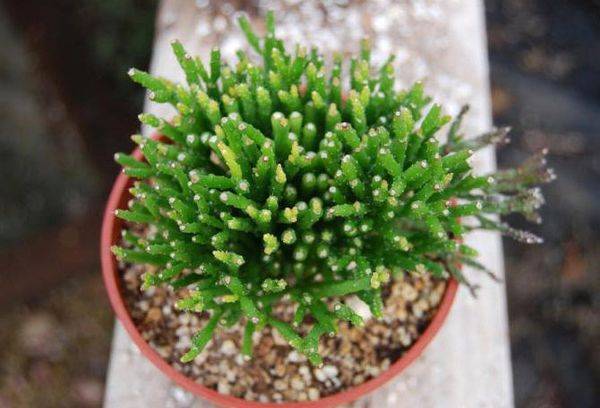
Hachior salicorniform
Hatiora salicornioides blooms very beautifully - bright yellow flowers appear, but in order to see them, it is necessary to create optimal conditions for the plant.
Varieties
Six varieties are most suitable for growing at home:
- Hatiora pink has flat stems of an elliptical shape, bright green, with a reddish tinge, during flowering, large flowers of a pale pink color are formed.
- Hatiora five-winged - a plant with ribbed stems, similar to a small bush, small, white flowers.
- Hatior gertner - stems are flat, have an elongated ellipse shape. It differs in large segments, up to 7 cm in length. Budding is usually in the spring, with red funnel-shaped flowers.
- Hatiora graser is hybrid and obtained by crossing Gertner with pink. Flowers in most cases are red-burgundy, but sometimes other shades are found. The shape of the segments is elongated, elliptical.
- Hachior salicorniform is characterized by an extraordinary branching of stems, reminiscent of bottles and consisting of many small segments. In general terms, the plant resembles a low (40 cm) lush tree. Flowers in shape resemble bells, can be pink, yellow, red.
- Hatiora salinosa also branches strongly, due to which it forms voluminous bushes. The stems consist of small segments, the length of which does not exceed 2.5 cm. The flowers are also medium-sized, salmon or yellow-orange.
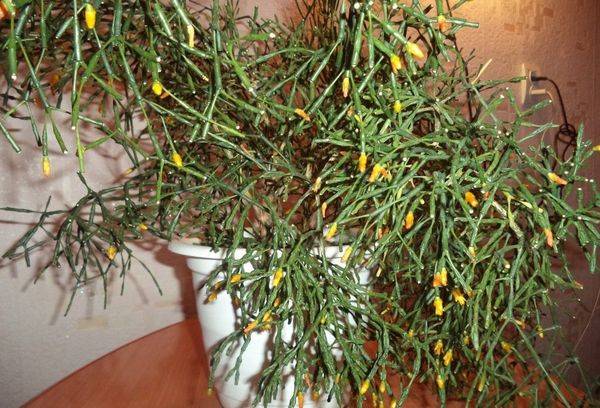
Hatiora saltwater
Home care: light and heat
Popular varieties of hatioras grow and breed well indoors due to their undemanding nature.
Lighting. Hatiora can develop in a shaded and well-lit room, but still the window sill of the west or east window would be the best option. A plant located on the south side will need to be protected from direct sunlight (their effects are fraught with burns). A hatior located on the northern windowsill will need to be illuminated with a phytolamp. With inappropriate lighting, flower growth will slow down, and the flowers will be small and rare.
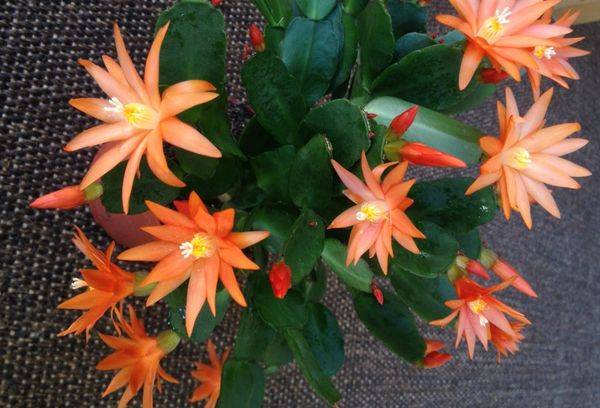
Hatior Gertner
Temperature mode. Normal room temperature in the range from +18 to + 23˚ С for the hator will be quite suitable. For laying buds in autumn, a flower needs special care. Create conditions for a period of rest: lower the temperature in the room. For a maximum of two months, the thermometer should not be below + 10˚ C or above +17.In the summer months, the plant is allowed to take out to fresh air, but it is necessary to provide shading from the hot rays of the sun.
Tip
Hang the pot with hatiora on one of the lower branches of the tree: under the crown the plant will be very comfortable.
Moisturizing
Art atmosphere. For hatori dry air is part of the natural habitat, because it tolerates insufficient moisture well. On especially hot days, additional foliar watering will be required. In the heat, spray the flower from the spray bottle, put wet pebbles or expanded clay in the pan of the pot, a fountain next to the plant would be a good idea.
Watering. In the warmer months of the year, the hator needs abundant watering. She is a succulent, that is, it accumulates water in the stems. The lack of moisture in the soil manifests itself in wrinkling and shortening of shoots, but if the flower is watered, it returns to its perfect shape. Prolonged drought will lead to dropping segments.
The plant should be watered when the top layer of the soil mixture in the flowerpot dries well. Soft, well-settled (at least 12 hours) slightly warm water is ideal for the procedure. 30-40 minutes after watering, drain excess fluid from the pan.
Excess moisture in the soil is fraught with decay of the root system. In winter, the plant needs moderate watering, and in autumn, during dormancy, it is completely stopped.
Soil and fertilizer
Priming. The ready-made mix intended for growing cacti and succulents, which is widely presented in flower shops, is ideal for hators. In order to make a suitable substrate with your own hands, you will need to take in equal proportions turf and leafy soil, humus and sand. It is important that the soil is loose and has good breathability, be sure to lay a drainage layer on the bottom of the pot.
Tip
purityis.decorexpro.com/en/ recommends adding a little peat or brick chips to make the soil mixture looser.
The soil must have a slightly acidic or neutral reaction.
Top dressing. Mineral fertilizers should be applied twice a month, at the same time as watering, during flowering and active vegetation. The content of calcium and nitrogen in the solution should be minimal (nitrogen causes decay of the root system of cacti). Choose fertilizers for fertilizing, in which the nutrients are contained in the following proportion: for 24 parts of potassium, 18 parts of phosphorus and 9 - of nitrogen.
Reproduction and transplantation
Hatiora propagated by cuttings: unscrew the fragment, consisting of 2-3 segments, sprinkle the resulting wound with crushed coal. Put the stalk for 3-5 days to dry, and then plant in wet sand or substrate. Watering the cuttings should be done exclusively through the pan and only after the soil has completely dried. With proper care the next year, a flowering bush will form from the cuttings.
Sometimes segments detached from the plant fall on the soil mixture and sprout without assistance. Hatoria reproduction will not cause difficulties even for beginner gardeners.
A plant transplant should be made in the spring after flowering. In this case, special attention is paid to the size of the pot: it should be low, the root system must leave 1 cm of free space for growth. Young haters must be transplanted every year, adults - once every 2-3 years. Very large specimens are allowed to be relocated even less frequently - once every 4-5 years.
Pests and diseases
The most dangerous for the hator are whiteflies, spider mites, scale insects and mealybugs:
- spots of white color on segments indicate an invasion of the latter;
- damage by a spider mite is indicated by yellow dots on the stems;
- the painful appearance and yellowing of the plant indicate the appearance of a scale insect and whitefly.
Manual collection of insects, a hot shower (water temperature should be no more than 40 ° C) and spraying with a soap solution will help get rid of pests with a small number.
In case of severe damage, the hator should be treated with an insecticide in accordance with the instructions for use several times. The interval between sprayings should be 7-8 days. Suitable "Aktara", "Actellik", "Confidor."
Of the diseases, the hator often suffers from a bacterial infection, late blight, and fusarium infection.
A bacterial infection is manifested by slippery, moist spots on the shoots. To get rid of the scourge, remove the infected segments and treat the plant with an antibacterial agent. Unfortunately, treatments do not always give the desired result. To save the flower, tear off the healthy segment and grow a new hatoru from it, and discard the diseased plant so that the infection does not creep onto the seedling.
Phytophthora and fusarium affect the root neck. Shoots become pale and wilt regardless of the degree of moisture of the substrate. Treatment with fungicides.
Useful Tips
A few recommendations from experienced floriculturists to care for hatoria:
- A plant does not bloom if there are not enough nutrients in the substrate or a dormant period with a low air temperature and minimal watering.
- The segments begin to fade and wrinkle with very dry, hot indoor air and insufficient watering. The situation will be saved by spraying and moistening the soil mixture.
- Segments may fall off, and buds may fall off if the roots are rotten, the air temperature in the room is too low, pests have settled on the plant or it has become ill.
Signs and superstitions
Some believe that the hator appeared in the house brings discord and scandals to the family, they often blame the plant for the female loneliness and grooming of husbands. Scientific data that would confirm such a superstition does not exist, therefore, everyone decides for himself whether to believe the hypotheses about the negative effect of the flower on family happiness.
Like any other indoor plants, the hatiora needs care, but the main secret of successful cultivation is moderation and observance of the rest period. For a fraction of the love and care shown, the flower will thank you with bright flowering and delicious curly branching.
